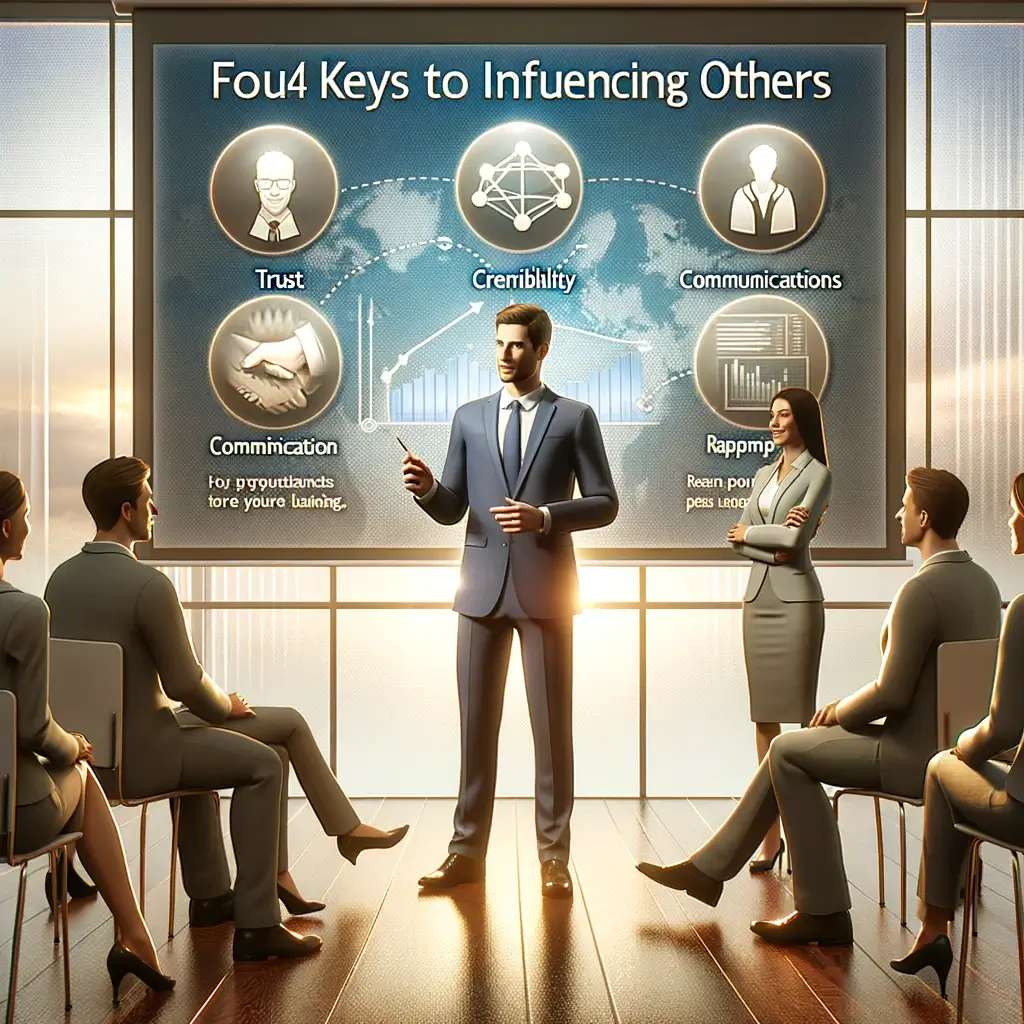Based on best practice, there are four major keys or components a manager must be aware of to successfully influence his/her subordinates and convince them why they must achieve a certain task or get something done specifically if there is some resistance to implementing the new ideas, below is an overview of the process
1. Setting Goals and Creating Expectations
Part of any manager's responsibility toward himself and others (whether subordinates, colleagues or boss), is to make sure that they are fully aware what she/he must expect them to achieve. One of the main reasons for relationships going wrong in the work environment is the failure of one person or both to make it clear what they want from each other. There is little point in a manager criticising a subordinate for non-delivery of results if the real problem is that the manager did not let the subordinate know what she/he wanted in the first place. Yet this is very common.
Influencing others in this way is however, quite a straightforward process. It is basically about being assertive. One of the reasons people fail to exercise assertive behaviour is that they confuse it with aggressive behaviour. See also: Behavioral Styles
There are four key stages to success in this style:
A. People who use this assertive style go out of their way to let other people know what they want, expect or require of them. They are specific and detailed in communicating their requirements to others. They also put a lot of effort into avoiding ambiguity and uncertainty in establishing what is expected.
Another way of looking at the same process is to recognise that each person involved has the right to know where he/she stands in relation to the other. This represents the basic 'contract' between two people and it is not an issue for negotiation.
For example, a sales manager who reasonably expects a representative to increase sales by 20% over the next year should not have the target negotiated downwards by the representative (unless there are special reasons unknown to the manager). Equally, for the representative to be able to deliver, he/she would need to know what the figure is in the first place.
The behavioural skills associated with success in letting people know where they stand are largely verbal. In being assertive, use words and phrases like:
I expect....……….
I want....………….
I must have....…..
AND NOT
I would like you to......
If you don't mind......
Would you please......
The latter create the expectation that there is room for negotiation and invite responses like, "I do mind....." or "but I would like to do this and not that."
Equally, your non-verbal behaviour needs to show the other person that you mean what you say, therefore be serious, without being severe. Smiling when you say: “I want you to ......" may cancel out the impact of the words.
B. The second step is to let the other person know what criteria are going to be used to judge success i.e. what standards will be used in assessing the performance or behaviour of the other person. These too, need to be set out clearly and unambiguously in concrete terms.
C. An important third feature of this style is to establish the consequences i.e. what will happen if you are successful, or if you let me down? The game of consequences is important. There is little advantage in being clear about what you expect from others if they don't know what meeting your expectations, or letting you down, is going to mean to them. State what will happen if the expectations are met and what will happen if they are not.
D. The final crucial step is the follow-up. It does not matter how much effort is put into the earlier stages unless others know from experience of working with you that it really matters whether they succeed or fail. A high performing subordinate's commitment will go down quickly if he/she sees that there is no advantage and that people who are far less effective get away with it.
How can it go wrong?
• By missing out one or more of the 4 steps or by performing them badly
• By making unrealistic promises or threats in Step 3
• By allowing your personal judgments, values or prejudices to get in the way in Step 1 (e.g. setting goals which matter to you but which are not objectively necessary)
• By over-emphasising the threats at the cost of the positive inducements in Step 3. The ground rule here is `catch people when they are doing something good'
The essence of this style is that it is what you want from others. When you are using it, you are in effect pushing the other person to do something, whether they want to do it or not.
2. Getting Commitment
Once the basic ‘contract' in a relationship has been established, it is a powerful advantage for a manager to be able to secure genuine commitment to ideas and actions from other people. If the first style is concerned with setting the ground rules, this one is about understanding what the other person is capable of contributing and creating conditions under which the best possible use is made of the resources and competencies of the other person in partnership with you. It is an influencing style through which others are given the opportunity to develop.
Its success depends on you doing a number of things well:
A. Involving others in a genuine way in decision making and problem solving activities. People who are encouraged to take an active part in deciding what needs to be done and how it is to be done, are usually more committed to carrying it out. The style pulls rather than pushes.
A key advantage here is that a person who wants to do something needs far less direct supervision or control, partly because they understand more fully why certain activities and successes are important.
B. Gaining commitment is greater to the extent that others feel:
• They have the resources (including personal skills and experience) relevant to the task
• Their contributions are received and understood by you, you value their contributions and give feedback
• The atmosphere is one of mutual trust and co-operation; this includes not setting traps for people, giving them the credit rather than keeping it for yourself and accepting that mistakes sometimes occur and that they should be used as an opportunity to learn rather than allocating blame.
• That their contributions will not be belittled or ignored
• That the atmosphere is open and non-defensive, i.e. basic honesty in communications, accepting and giving constructive criticism
C. Listening actively. This is an important contributor to getting others to believe in themselves and in you. It is by listening to other people’s ideas that you can check mutual understanding. Active listening involves asking the right king of questions e.g.
• Let me see if I understand. What you seem to be suggesting is ………….
• Tell me more about ……………….
• How do you think we can…………………..
• Let me summarise our discussion ………………..
• So you think that ………………
These questions are designed to draw out contributions from others and for showing understanding and appreciation.
D. Focusing on the other person’s strengths rather than weaknesses.
E. Extending and building on the other person’s ideas rather than pushing your own proposals. This includes being open about your own limitations and lack of knowledge rather than scoring points or attempting to learn by stealth.
F. Creating space for others to get on. This includes giving freedom and personal responsibility in work.
Not surprisingly this style is the one which is most useful when you are concerned with delegating as the basis for helping other people ‘grow’ and so that they can make the best possible contribution over and above the basic contract established by the first influencing style.
3. Creating Enthusiasm and Generating Energy
Any manager will sometimes need to secure sustained high performance levels, get others to pull out all the stops to handle a crisis, persuade people to pull off short term goals in going for the`big one', or influence a previously badly managed group to accept and work energetically for a better future that can be achieved if they are all prepared to pull together to get there. This third style is about influencing others to do just these kind of things.
It differs from the other styles in that it aims to create excitement, energy and a shared enthusiasm by making appeals to the emotions and values held by those being influenced. Its strength is derived from several key features:
A. Its strategy is to identify and articulate a sense of shared, or common, purpose relating to an important future objective/goal.
B . It strengthens people's beliefs that the goal out there is worth going for (i.e. the payoff will be high) and that it can be achieved if they all pull together to achieve it.
C. It mobilises energy and a sense of excitement by activating the feelings of strength and confidence that are generated by being part of a group which shares a common sense of purpose. It is therefore a style which you are most likely to use with a group rather than an individual.
D. It makes its appeal to people at the level of their hopes, values and aspirations. Not surprisingly, some of the more visible examples of the style come from political, military and social leaders, e.g. Martin Luther King (I have a dream), Kennedy (Ich bin ein Berliner), Bob Geldof (Feed the world).
Associated with the effective use of this style are some important skills:
• Knowing what will turn people on. This means understanding what their hopes and aspirations are and appealing to them. Many companies experiencing severe cut-backs over the last few years have been able to appeal to the remaining work-force's deep seated desire for security as the basis for dramatic improvements in performance and enthusiastic energy.
• Being able to put together and communicate a vision for the future. Some kind of ideal to work for. This gives a group a sense of direction and common purpose.
• Being enthusiastic yourself when communicating this sense of shared objective. Enthusiasm is infectious and helps to counteract the "we've heard it all before" response from people. You need to believe in the idea yourself.
• The ability to paint vivid pictures with your words that generate excitement about the possibilities that exist in an idea or project.
The style is often found to be invaluable as the basis for influencing people to accept change. It involves finding what is good about the change and how it is going to benefit those involved.
4. Using a Logical Argument
There are many situations at work where people can be influenced to do things by simply being given the reasons why. People who are given the facts are much better placed to make decisions and judgments.
This style places an emphasis on the use of facts, data, expert opinions and logic as the basis of persuading others to accept an idea, a way of doing something or an argument in favour of some course of action.
It differs from the first style in that it relies on logical argument rather than the use of status or power (I want this done because I am the boss), and from the third style in that it appeals to reason rather than emotion. Many people with a background in a scientific discipline are often best influenced in this way and will themselves tend to use it when attempting to influence others.
Success in using this style depends on the ability to do a number of things well:
• Putting forward ideas, proposals and suggestions about what to do and how to do it
• Testing the reactions of other people to your ideas
• Collecting together all the evidence, facts and information about an idea. Putting a good case in support of what you want to happen
• Anticipating the arguments other people may put up against your idea and have counter¬arguments ready. As with the other styles success comes with preparation and practice but with this style, doing your homework is crucial.
For more on conflict resolution, check out our instant download Conflict Resolution training package.














































































